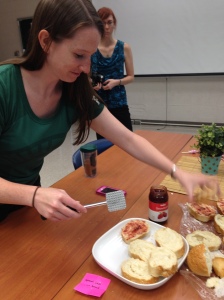When we were told we would be cooking this morning, I immediately looked around my group, hoping that I could be a bystander or curator, rather than a chef. After the first direction, however, it was clear that no amount of cooking experience would help us today.
Direction 1: Grab a “vessel”
Direction 2: Grab a “tool/utensil”
Direction 3: Pick a sticky note out of a hat (to see what we would be making)
To say my group was lucky, would be an understatement. My classmate, Laurie, was the first person to choose the vessel and tool, and unknowingly grabbed a pitcher and a whisk. Our sticky note: whipped cream. Looking at the garlic press, the meat stamper (apologies for the lack of cooking vocabulary), and the knife, it was clear she had unknowingly chosen the right tools.

We found that making the whipped cream was easy, given the tool and vessel we had chosen. We did notice, however, that other groups were not as fortunate. Another group chose a plate (good call) and the meat stamper (very, very bad call). They were asked to make jellied toast (yikes).

Over the weekend we got a glimpse into TPACK. For those outside of the MSU EdTech community, TPACK is a specific kind of knowledge known as technological pedagogical and content knowledge. (Mishra & Koehler, 2009). TPACK originated here in East Lansing, when Punya Mishra and Matthew Koehler (2009) discovered that there is a special knowledge that lies at the intersection of content, pedagogy, AND technology. Mishra and Koehler say that “teachers need to develop a willingness to play with technologies and an openness to building new experiences for students so that fun, cool tools can be educational” (Mishra & Koehler, 2009). The cooking lesson we had today, was in fact not about food at all. This weekend, we read about TPACK, today, we learned about TPACK.
After creating the food, we saw clearly that by choosing our tool and pedagogy first, it was harder to implement the content. As a class, we discovered that in each challenge, we successfully created an edible breakfast item. Some tools were right for the job (good guessing) and other tools had to be adapted, but all tools were able to be used. In our group, we had chosen tools that one might normally use to make whipped cream. In this case, I considered the idea that in the classroom I might start with a tool and get lucky with the integration of the content. I also considered that if we had gotten the garlic press, for example, things could have gone horribly wrong.
One additional consideration, was that in order to make the whipped cream, I needed my whole team. We could not have made it without each other. When one of us got tired of whipping, we passed the baton (so to speak) so that we could avoid getting too tired. It was also difficult to whip with such a small opening at the top of our vessel, since we couldn’t hold the handle of our pitcher. We noticed there was a crack in the class and to avoid shattering it, we decided to handle it differently. I believe this could be a metaphor for adjusting a lesson in real time. Even the best laid plans can go awry (Of Mice and Men anyone?) and teachers need to be ready for it!
This activity reinforced the idea that the content needs to precede the tool. There will always be room for creativity, and the other tools will still be on the table, ready to be used, but if we begin with the tool, we leave little room to adjust. If we begin with the content, we allow ourselves to choose any tool from our box (or several tools) and create a lesson that is both engaging and motivating. Laurie, our physic tool-chooser, made our job easy today, however it didn’t make us lose sight of the bigger picture, and the TPACK consideration.

TPACK asks teachers to look at how the content, pedagogy and technologies can work together to create a learning experience, rather than looking at ways to simply add technology or insert the content into a new device. Thank you Punya and Matthew for changing the way we look at technology integration, I am proud to have fellow #Spartans at the forefront of teaching in the 21st century! Credit to: Mishra, P. & Koehler. M. J. (2009). Using the TPACK framework: You can have your hot tools and teach with them, too. Learning & Leading with Technology, 36(7), 14-18. Pictures are mine.

I enjoyed reading your post. We did this same activity here in Galway and had a lot of fun with it. Linking the activity to the mindset that TPACK relies on was a great way to explain how it all works. -Jason
LikeLike
Thanks! I will be coming to Galway for year two, I can’t wait to come join the overseas cohort with you guys!
LikeLike
[…] our class today, we collaborated by Cooking with TPACK, and ultimately learned how to combine technological knowledge, content knowledge and pedagogical […]
LikeLike
I enjoyed your point of view during your explanation of the activities and lucky utensil choice. I also thought that the way you draw a parallel between content preceding the technology tool in TPACK, and understanding the breakfast task before choosing your utensil, showed you have a clear understanding of the TPACK framework.
LikeLike
Thanks for the feedback Taylor!
LikeLike
I really, really like how you pointed out that you got really lucky with having the right tool for the job in your case but that, with flexibility, you can find a way to “make it work.” Your understanding of the principles of TPACK is very clearly stated. Bravo!
LikeLiked by 1 person
Thank you Erin! I appreciate the feedback!
LikeLike